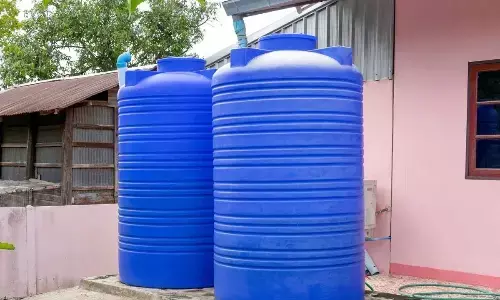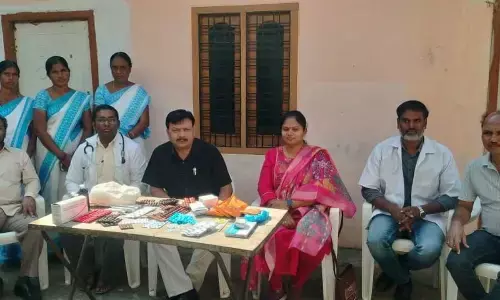Reform agri extension to boost ryots income

Right information at right time through appropriate channels is crucial for farmers to take informed decisions about what crops to grow, what quantity of fertilisers and pesticides to be used, and when and where and at what price to sell
Right information at right time through appropriate channels is crucial for farmers to take informed decisions about what crops to grow, what quantity of fertilisers and pesticides to be used, and when and where and at what price to sell.
Historically, it is the responsibility of public agricultural extension system to provide all this information to farmers. However, public extension system has over the years been burdened with non-extension works like distribution of subsidies and inputs, with little time left to attend to core extension activities like advising farmers on new practices and techniques.
The national objective of the doubling of farmer’s income by 2020 cannot be achieved without the successful delivery of agricultural extension. One concern is most of the agricultural officers positions are vacant in many states. The ratio of extension workers to farmers is low at 1:1162 at national level (one agricultural officer serving 1162 farmers) as against recommended ratio of 1:750.
After liberalisation in 1990s, agricultural extension is constrained by limited budget allocation. At national level, expenditure on agricultural extension is only 0.16 per cent of agriculture gross domestic product (GDP), which is quite low when compared to international standards. There is an immediate need to increase focus on agricultural extension.
Increasing information needs of farmers
Given that farmers are moving from subsistence to market-oriented farming, there is increase of information needs not only on production practices like suitable new crop varieties, but also on market-oriented information like trends in harvest season prices, quality of produce and export markets. Several government schemes like crop insurance, subsidy on farm implements and electronic agricultural markets are knowledge-intensive, which needs to be catered to through widespread dissemination of information.
Need to promote multiple channels
As public extension system alone cannot meet the growing information needs of the farmers, there is a need to promote alternative channels of information dissemination. Some channels like input dealers, private companies (ITC e-choupals; TATA Kisan Kendras), farmer producer companies (like MAHAGRAPES, an FPC of grape farmers), cooperative societies like Mulkanoor society, some NGOs like Bharatiya Agro-Industries Federation (BAIF) and Action for Food Production (AFPRO) are already active in providing information to farmers on right type of seed and fertilisers, besides providing forward and backward contracts. However, they are not backed by proper promotional and regulatory mechanism, government should take an initiative to promote them through institutional mechanism. At the same time, this will help in safeguarding farmers from any misguided information.
Low-cost ways to
reach more farmers
In spite of efforts by both public and private agencies, it has been found that the reach of the agricultural officers as also extension agents from private agencies is limited. To enhance the last-mile connectivity, under Agricultural Technology Management Agency (ATMA), the government is recruiting progressive farmers as farmer-friends with a monthly honorarium.
These farmer-friends will have good knowledge and ability to connect and influence fellow farmers to adopt new technologies. In popularising farmer-friend approach, government should take lessons from Banking Correspondence model for financial inclusion in reaching the last mile connectivity, which is considered as highly successful initiative in promoting financial inclusion. Employing one farmer-friend for every two-villages and engaging one for each remote village will enhance local knowledge dissemination.
Make use of ICT
Most of the ICT tools are available at cheaper rate now. Some ICT interventions like wall-projectors, low-cost short films, handheld devises, mobile-based services, Kisan Call Centres (KCCs) are already successful in many parts of the country, which needs to be popularized both by public and private extension workers. Now almost every farmer-household is having mobile phones.
The high penetration of mobile phone needs to be used for dissemination of information. Whatsapp groups are also becoming popular, but farmers who don’t have smart-phones are excluded from the whatsapp groups, this increases digital divide. This needs to be addressed through alternative channels.
Public-private partnerships
The dynamism and market-oriented approaches of private companies needs to be used by the government officials to popularize improved varieties, pumpsets, farm machinery, small implements, bio-fertlisers, etc., where private companies have some commercial interest, at the same time they help in increasing awareness about new technologies.
Public private partnerships need to be encouraged through promotion of rural advisory services especially in hi-tech agriculture, where private sector is strong for the enefit of the farmers.
In the scenario of expanding private sector extension and declining funds for the public sector, there is a danger of concentrating on large farmers mostly in irrigated areas, and neglecting small, marginal and women and rainfed farmers. Hence, the government should incentivise private sector to cater to these neglected areas and people.
Training of officials
Although government agricultural officers are known for their technical skills, sometimes they lack communication skills and market information. The training institutions should impart communication skills and market-oriented skills like trends in prices, and demand outlook for commodities produced locally. How to use different types of information channels like whatsapp, mobile SMS, projectors etc.
Private sector and public sectors should complement each other in usage of these techniques and the same needs to be incorporated in District Agricultural Plans. Block-level agricultural officers are implementing multiple schemes simultaneously. They need to be trained in monitoring of these schemes from identification of beneficiaries to disbursement of machinery, so that they can effectively implement these schemes with limited time and spend more time on information dissemination.
Operational autonomy
Agriculture officer’s work involves a lot of field work, identifying and diagnosing local problems and co-evolving solutions in partnership with local stakeholders is key responsibility. Hence, they need operational autonomy to take local decisions like involvement of private sector partners in extension, training and demonstrations.
Agri & allied activities
Farmers are increasingly dependent on livestock like dairy and goat farming. Animal husbandry and dairy together contributes to 26% of agricultural GDP, but only 0.9% of agricultural extension budget is allocated for development of this sector. There is a need for enhancing budget and manpower allocation for animal husbandry to increase farmer’s incomes.
All these measures need innovations backed by sufficient budget, at least 1% of the agricultural GDP needs to be allocated for agricultural extension, so that the objective of doubling farmer’s incomes by 2022 will be achieved.
By: A Amarender Reddy
(Writer is Director, National Institute of Agricultural Extension Management, Hyderabad)




















